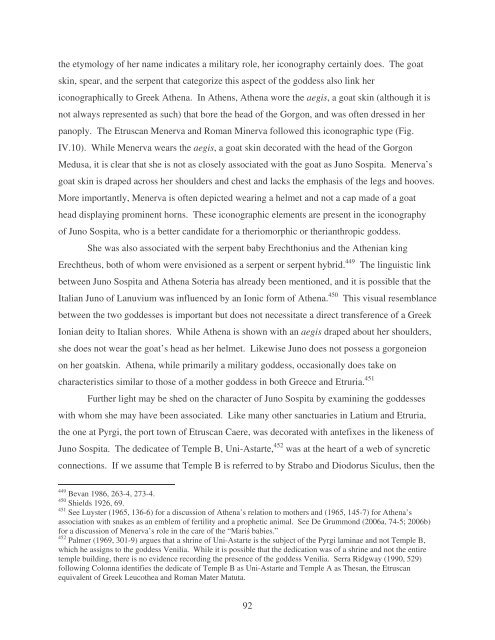Final Draft - Preview Matter - Florida State University
Final Draft - Preview Matter - Florida State University
Final Draft - Preview Matter - Florida State University
You also want an ePaper? Increase the reach of your titles
YUMPU automatically turns print PDFs into web optimized ePapers that Google loves.
the etymology of her name indicates a military role, her iconography certainly does. The goat<br />
skin, spear, and the serpent that categorize this aspect of the goddess also link her<br />
iconographically to Greek Athena. In Athens, Athena wore the aegis, a goat skin (although it is<br />
not always represented as such) that bore the head of the Gorgon, and was often dressed in her<br />
panoply. The Etruscan Menerva and Roman Minerva followed this iconographic type (Fig.<br />
IV.10). While Menerva wears the aegis, a goat skin decorated with the head of the Gorgon<br />
Medusa, it is clear that she is not as closely associated with the goat as Juno Sospita. Menerva’s<br />
goat skin is draped across her shoulders and chest and lacks the emphasis of the legs and hooves.<br />
More importantly, Menerva is often depicted wearing a helmet and not a cap made of a goat<br />
head displaying prominent horns. These iconographic elements are present in the iconography<br />
of Juno Sospita, who is a better candidate for a theriomorphic or therianthropic goddess.<br />
She was also associated with the serpent baby Erechthonius and the Athenian king<br />
Erechtheus, both of whom were envisioned as a serpent or serpent hybrid. 449 The linguistic link<br />
between Juno Sospita and Athena Soteria has already been mentioned, and it is possible that the<br />
Italian Juno of Lanuvium was influenced by an Ionic form of Athena. 450 This visual resemblance<br />
between the two goddesses is important but does not necessitate a direct transference of a Greek<br />
Ionian deity to Italian shores. While Athena is shown with an aegis draped about her shoulders,<br />
she does not wear the goat’s head as her helmet. Likewise Juno does not possess a gorgoneion<br />
on her goatskin. Athena, while primarily a military goddess, occasionally does take on<br />
characteristics similar to those of a mother goddess in both Greece and Etruria. 451<br />
Further light may be shed on the character of Juno Sospita by examining the goddesses<br />
with whom she may have been associated. Like many other sanctuaries in Latium and Etruria,<br />
the one at Pyrgi, the port town of Etruscan Caere, was decorated with antefixes in the likeness of<br />
Juno Sospita. The dedicatee of Temple B, Uni-Astarte, 452 was at the heart of a web of syncretic<br />
connections. If we assume that Temple B is referred to by Strabo and Diodorus Siculus, then the<br />
449 Bevan 1986, 263-4, 273-4.<br />
450 Shields 1926, 69.<br />
451 See Luyster (1965, 136-6) for a discussion of Athena’s relation to mothers and (1965, 145-7) for Athena’s<br />
association with snakes as an emblem of fertility and a prophetic animal. See De Grummond (2006a, 74-5; 2006b)<br />
for a discussion of Menerva’s role in the care of the “Mari babies.”<br />
452 Palmer (1969, 301-9) argues that a shrine of Uni-Astarte is the subject of the Pyrgi laminae and not Temple B,<br />
which he assigns to the goddess Venilia. While it is possible that the dedication was of a shrine and not the entire<br />
temple building, there is no evidence recording the presence of the goddess Venilia. Serra Ridgway (1990, 529)<br />
following Colonna identifies the dedicate of Temple B as Uni-Astarte and Temple A as Thesan, the Etruscan<br />
equivalent of Greek Leucothea and Roman Mater Matuta.<br />
92

















